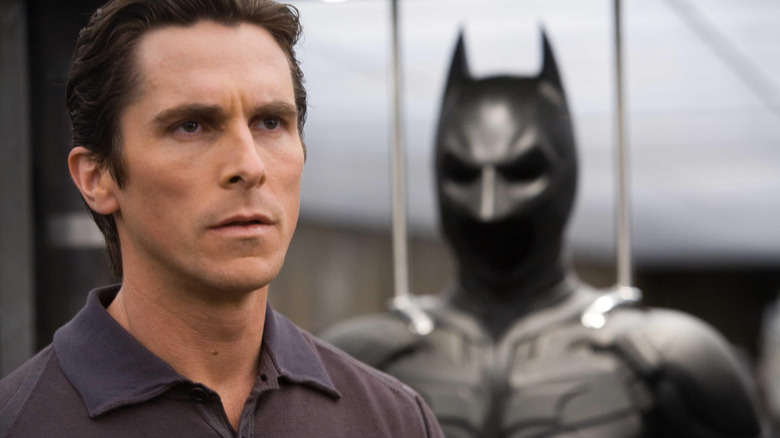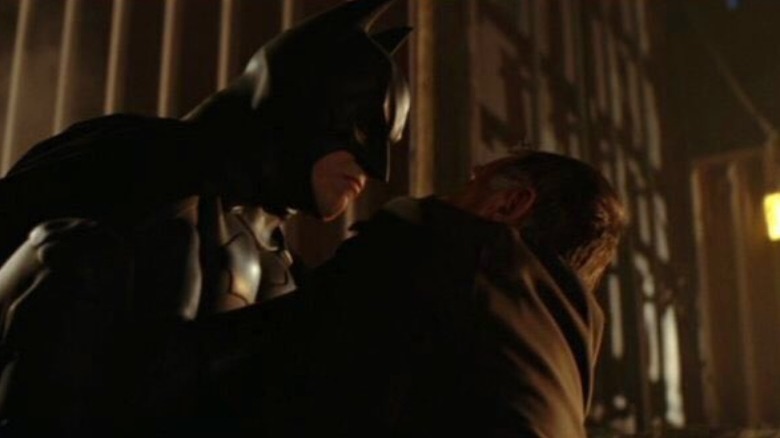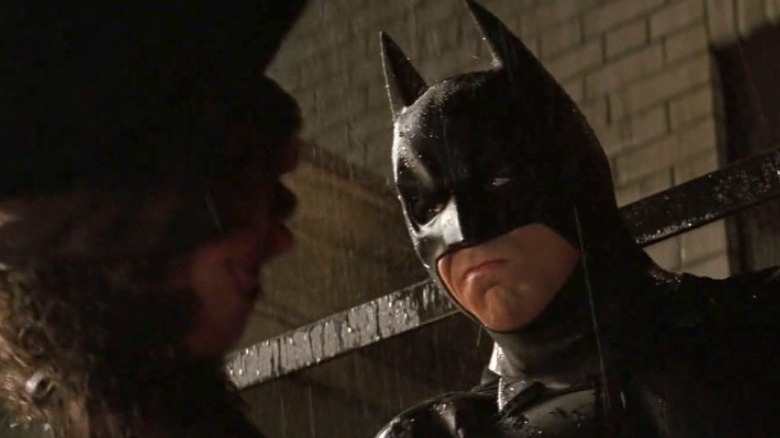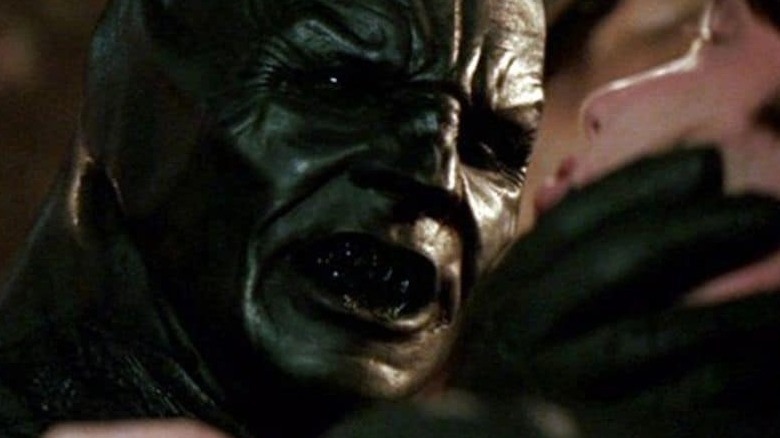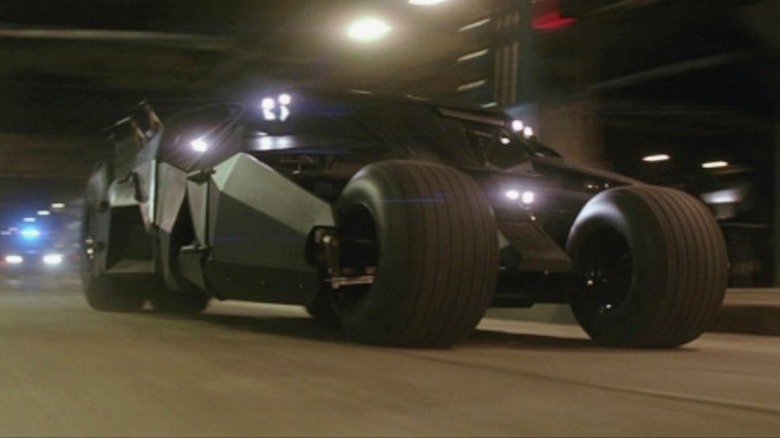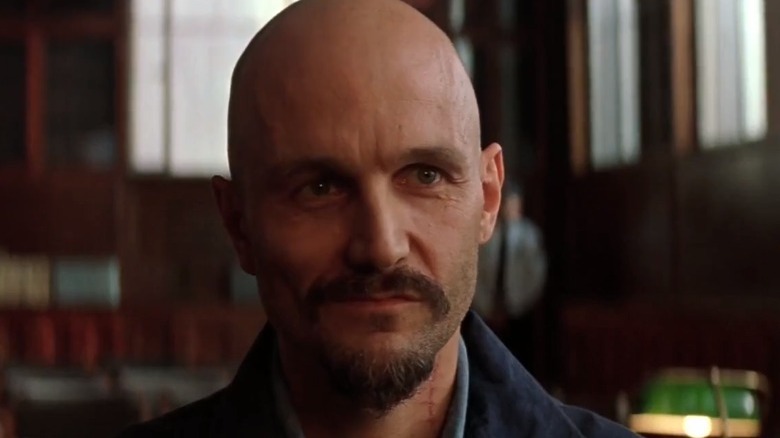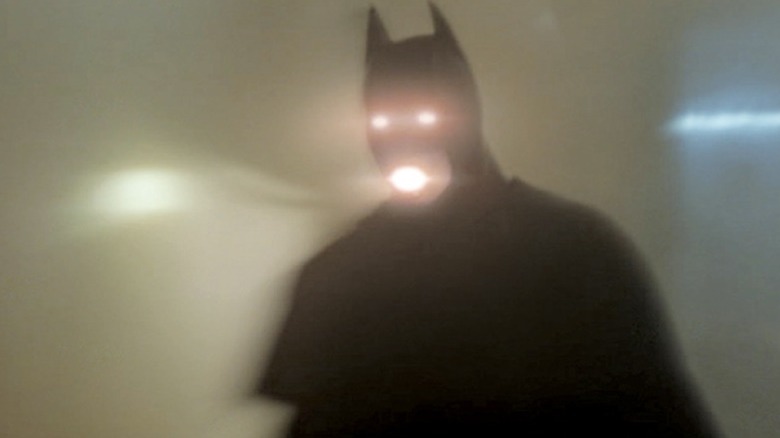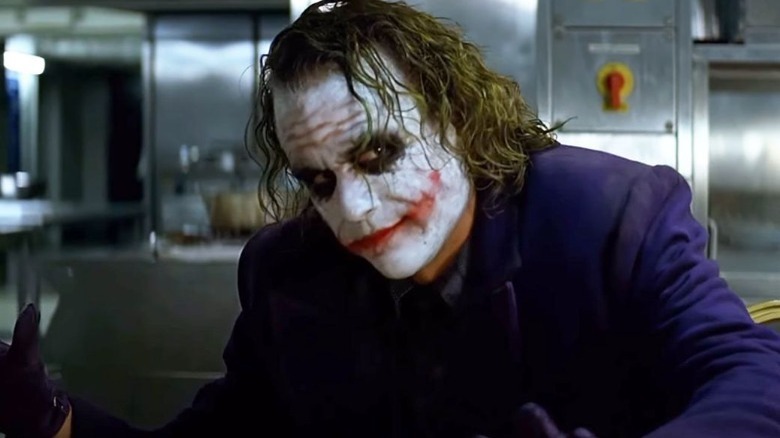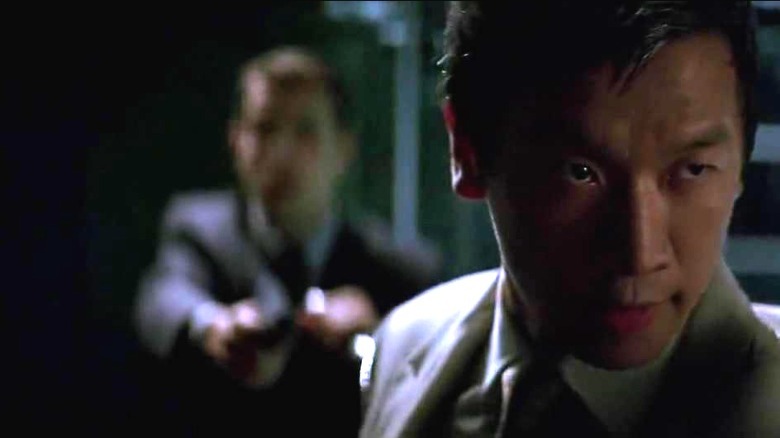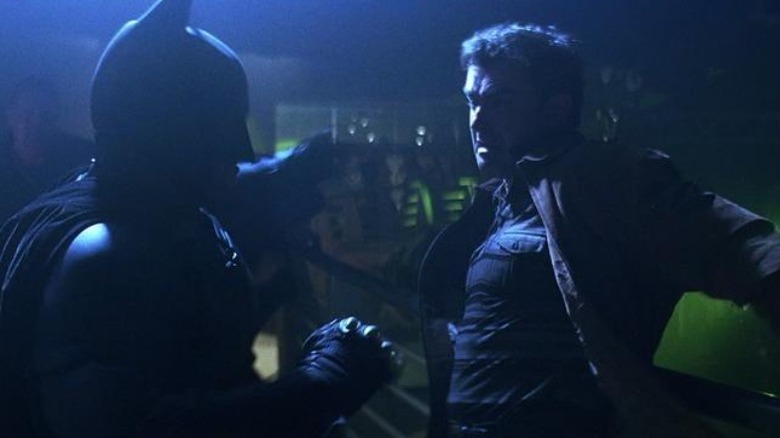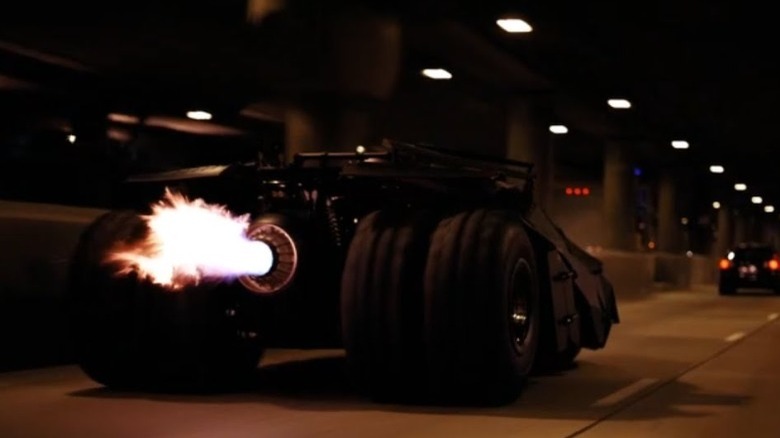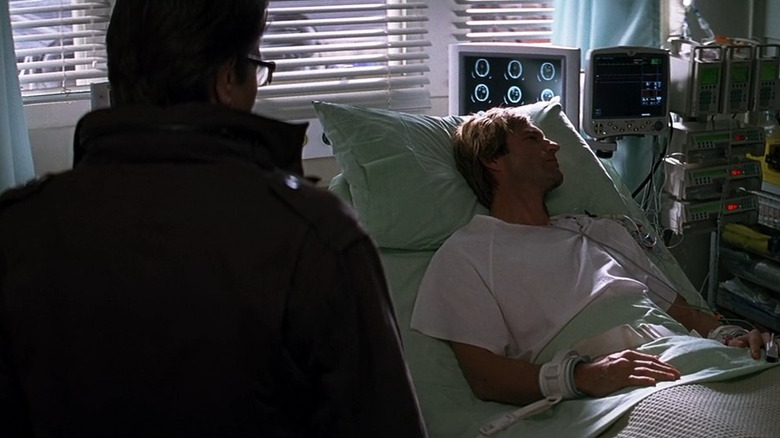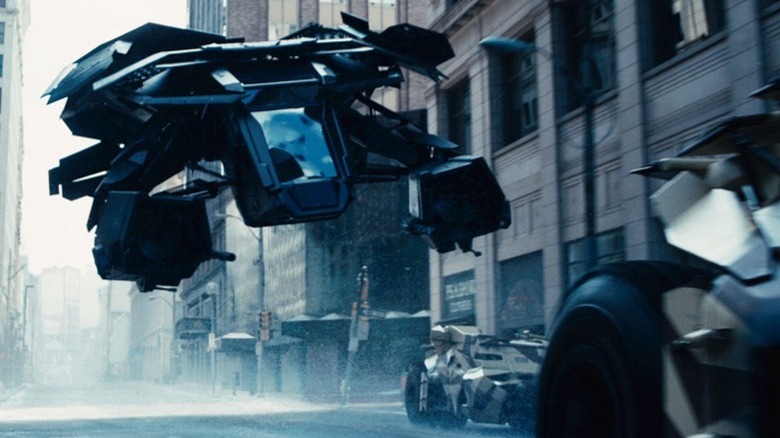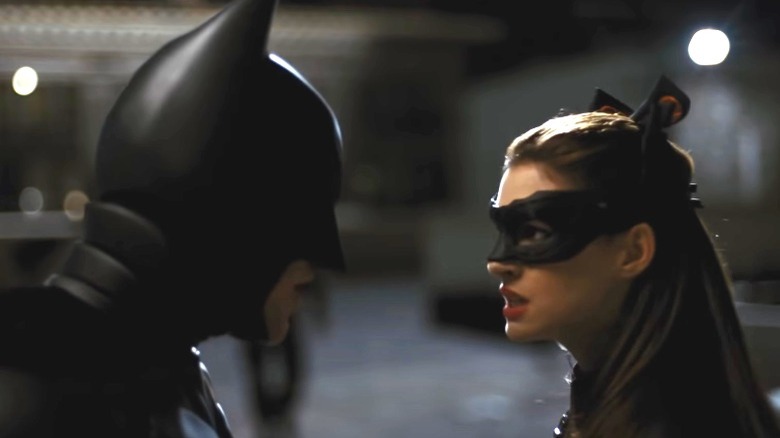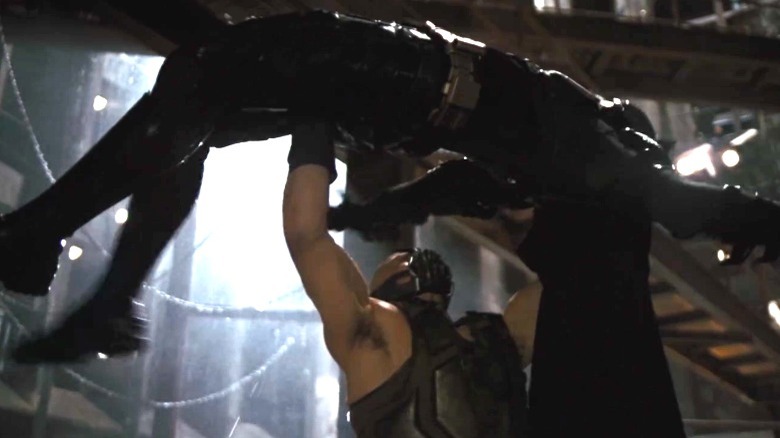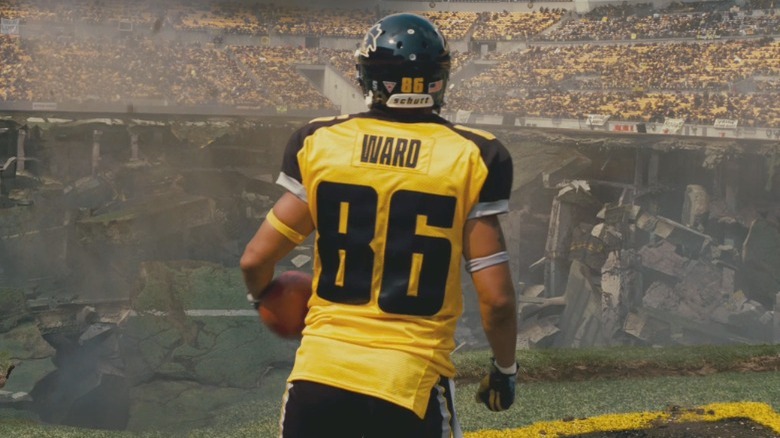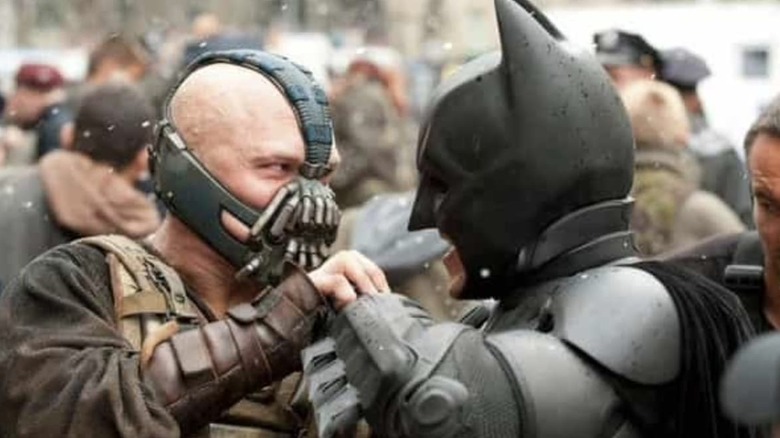The Most Pause-Worthy Moments In The Dark Knight Trilogy
Harboring a high intolerance for injustice, Bruce Wayne is driven to dole out punishment to the criminal element of Gotham City. Batman fully embraces the "dark" aspect of his Dark Knight moniker in Christopher Nolan's live-action version of the character. With Christian Bale underneath the cowl, Nolan gives audiences a glimpse at what Batman's story might look like if it were rooted in the real world. Bringing the insanity, emotions, and motivations of these comic book characters closer to home only serves to spark our imaginations and cause us to believe that a superhero could truly exist.
Nolan and crew create a world brimming with corruption. Judges and law enforcement officers are bought and paid for by criminal kingpins. With greed, violence, and corruption holding most of the power in Gotham, its easy to understand why the Batman must exist in this world. Despite his name, Batman isn't a "man" but a symbol, an icon that is pure and incorruptible. Unlike a man, a symbol can achieve immortality with enough work and effort. Bruce Wayne endeavors to create the legacy behind that symbol. Nolan's trilogy of films expertly portrays Bruce's crusade to ultimately save a city from its own darkness within. On screen, Batman's struggle is an intense delight fraught with danger at every turn. For the uninitiated, let's take a look at some of the most paused moments in this trilogy of films — scenes you'll want to watch more than once.
Batman's first appearance at the docks
As a film director, Christopher Nolan endeavors to serve the narrative first and foremost. As such, he carefully crafts the exposition on screen to create an atmosphere of anticipation. When the big moments do occur, the payoff is multiplied by the narrative layers that preceded them. As such, Batman doesn't actually appear in his suit, ready for action, until the hour mark in "Batman Begins." That's right, viewers have to wait a full hour to actually see Batman taking down criminals. However, by the time Bruce is ready to take out Falcone's goons at the docks, the audience is primed and ready.
This first look at Christian Bale's Batman unveils the character gradually, shooting his tactics of stalking thugs from the shadows like a horror film. We only catch brief glimpses of the ninja-like vigilante as he quickly snatches up bad guys from every dark corner of the pier. After Carmine Falcone exits his vehicle to see what all the commotion is, he retreats in fear and hides in the car, nervously gripping a shotgun and uttering, "What the hell are you?" Batman snatches the crime lord through his roof and pulls him close, exclaiming, "I'm Batman." It's a crowdpleasing moment that hails back to Michael Keaton's first time onscreen as the Caped Crusader in 1989's "Batman." The entire sequence is made to be paused and replayed for viewers to absorb the full effect of Batman's ghost-like entrance.
Batman interrogating Detective Flass
Gotham City's protectors aren't exactly selfless souls. While Jim Gordon might be a stalwart cop, his partner, Detective Flass, is a two-timing schemer who cuts corners and takes a paycheck from his criminal benefactors in order to grease the wheels of law enforcement and get away with their misdeeds. As a city, Gotham is so corrupt that Flass is pretty open about his second source of income. While he doesn't flaunt it, he also doesn't care to hide it from his straight-arrow partner. At one point, he openly swipes cash from a humble entrepreneur at a food cart selling falafel. Flask simply has no shame.
As he heads down a dark alley with his food, however, Flass gets a surprise. He's instantly flipped upside down by a wire and hoisted up several stories to dangle near a rooftop where Batman waits. Batman furiously grabs Flass by the hair and demands that he tell him where the rest of the drug shipment from the dock is headed, prompting this classic exchange: "I don't know," gasps Flass. "I swear to God..." "Swear to me!" Batman roars in response. He even induces a bit more fear into the visibly shaken Flass by pretending to drop him and then reeling him back up. Bale's performance alone is certainly ferocious enough to watch again and again.
Dr. Crane's drugged perception of a demonic Batman
Dr. Jonathan Crane, an Arkham Asylum psychiatrist, is also seemingly corrupted by the mob. However, while Carmine Falcone may have been a business partner, Crane's real superior winds up being the shadowy Ra's al Ghul. Despite playing games with the criminals of Gotham City, the end goal for Ra's and the League of Shadows is to destroy the metropolis. Dr. Crane takes the hallucinogenic flower provided by the League and manufactures it in aerosol form, making it capable of being inhaled by victims and projecting their own fears onto reality.
Having been dosed once with Crane's toxin, Batman is prepared this time for a second confrontation. After Dr. Crane and his thugs lace the city's water supply with the compound, Batman swoops in, snatches the good doctor and forces him to inhale his own concoction. In his stupor, Crane sees Batman as a dark, demonic-looking creature with a nasty black goo leaking from its mouth. It's a terrifying visual that underscores the power of Crane's toxin, and Batman's monstrous appearance will make any viewer pause to admire the hideous transformation.
The Tumbler jumping off rooftops
The Batmobile is a staple of any version of Batman's arsenal. It's meant to be a showstopper that is both capably intimidating and highly functional from a combat perspective. Furthermore, it also must have the means of making a quick getaway should the situation call for it. Under Commissioner Loeb's command, the police force only sees Batman as a lawless vigilante who must be taken in for his crimes. As Batman attempts to race back to the Batcave with Rachel Dawes, who's been poisoned by Dr. Crane's toxin, he first must evade law enforcement. The Batmobile, or Tumbler as it is officially designated in Nolan's trilogy, is the means to do just that.
Lucius Fox, the brains behind Batman's gear at Wayne Enterprises, taught Bruce all of the basics for operating this speedy and highly-maneuverable tank. One of its key functions is a vertical thrust. Fox refers to this as the vehicle's "bridging" capability enabling it to cross over gaps with well-timed vertical thrusts that basically make the automobile jump. Batman puts this functionality to the test as he drives along rooftops to lose his pursuers, jumping from building to building. It's a sight to behold, and it might make one wonder how a roof could withstand the weight of a tank without caving in. Perhaps the Tumbler is lighter than it looks — or doesn't stay in one place long enough.
Spotting the infamous villain Victor Zsasz
You'd be mistaken for thinking that Carmine Falcone, Ra's al Ghul and the Scarecrow are the only three Batman villains to turn up in "Batman Begins." After all, Batman has a rather extensive rogues gallery. While Batman's primary confrontation is with the three aforementioned villains, another popular antagonist of the Dark Knight makes a brief appearance in the film.
The serial killer known as Victor Zsasz receives a few moments of screen time in "Batman Begins." In comic book lore, Zsasz is a product of his own depression and anguish who believes that he has no purpose and attempts to end it all. However, before he can do that, he's attacked by a man with a knife. Victor stabs the man and kills him, feeling that he did the man a service by freeing him from his pointless life. From that point on, Zsasz goes on a killing spree, murdering people as his own perceived act of kindness while carving a tally into his body to symbolize each person he has slain. In "Batman Begins," he can be seen in a brief, early courtroom scene, and again later as one of the prisoners who escapes during the final act of the film. Avid Batman fans will recognize the noticeable tally scars on his neck.
The nightmare visions induced by the toxin
In the final act of the film, Ra's al Ghul's plan for Gotham to destroy itself is nearly complete. He has vaporized the water supply, releasing the aerosol toxin that it was laced with into the air. The toxin affects everyone in the Narrows and they begin to see horrific things. The idea is that the citizens of Gotham will fear everything and attack each other, effectively destroying themselves. Some of the nightmarish visions include civilians looking like monstrosities with skull-like heads or demonic eyes. When the Scarecrow goes on his rampage through the streets on his horse, Rachel Dawes and the young boy she is protecting see the crazed psychiatrist as a supernatural entity with glowing red eyes, whose horse can apparently breath fire.
Once Batman joins the fray, he glides overhead while those on the ground see him as yet another demonic creature with bat-like wings and glowing eyes. The warped hallucinations induced by the toxin run rampant in the final scenes of the film, offering viewers a brief shift from an action thriller to a horror film and a wealth of eerie images to pause on.
Joker's introduction and magic trick
Despite his blackened soul and sinister proclivity for mass chaos, carnage, and anarchy, the Joker was easily the most engaging character to watch in "The Dark Knight," superseding the titular hero himself. After all, the late, great Heath Ledger didn't win a posthumous Academy Award for a throwaway role. The actor took the Joker to new heights and gave the most praised on-screen Joker performance to date despite several others filling the purple suit.
The premise of "The Dark Knight" is that Batman has terrorized the mob and Gotham's criminals for quite some time. They've now become desperate and ultimately lend the radical Joker an ear and some resources. When the Joker waltzes into one of their daytime meetings, he offers to show them a magic trick. Getting impatient, one of the mobsters by the name of Gambol orders a man to take care of the intrusion. As Joker plants a pencil standing upright on the desk, he swiftly pushes the approaching man's face into it making it "disappear." It's a bit of dark comedy that suits the Joker rather nicely, establishing his erraticism and penchant for chaos and violence. And let's be honest, most of us paused the film to see if we could slow down that disturbingly morbid, but swift, magic trick.
Skyhook operation
Batman, Harvey Dent, and Jim Gordon are persistent in their takedown of the mob. As the D.A., Harvey intends to wrap up the entirety of Gotham's crime factions in a RICO case since they all pooled their money together in one giant pot. Participating in even one unsavory investment would indict everyone that contributed funds to the pool. Their accountant, Mr. Lau, has left the country in an effort to flee Harvey's jurisdiction. He is the only one capable of incriminating the mob. Furthermore, his home country of China won't extradite a national. As the Joker predicted, however, Lau may be beyond Harvey's reach, but not Batman's.
Batman plans a maneuver where he enters Lau's office, takes out his security detail and absconds with the criminal banker out of a window. Thanks to Lucius Fox's knowledge base, Batman's planned tactical exit is by way of an airplane that "doesn't land." The airplane flies overhead with a hook on its nose that latches onto a ballooned tether off the back of Batman, whisking him away amid danger. The extraction plan is a bit crazy, but it works beautifully.
Batman fighting in Maroni's club
The crusade that Batman, Harvey Dent, and Jim Gordon embark on is one fraught with peril. After all, the mob won't sit idly by while law enforcement effectively ends their careers and lives. Instead, they further embolden the Joker who begins to do what he does best. He wreaks havoc on the city. First, he stages an assassination attempt of the mayor during the funeral for Commissioner Loeb. Instead of the mayor, however, it appears that Jim Gordon is the one who takes the fatal bullet after shielding the mayor from incoming fire. The police department, Rachel, and Batman are all reeling from the alleged loss of Jim Gordon.
Bitterly, Batman hunts down Sal Maroni in an attempt to squeeze any valuable information from the crime leader that will help him end Joker's reign of tyranny. Maroni is sitting comfortably in a club while Batman makes his way through Maroni's security detail. Amid the strobe lights and the dark atmosphere, the silhouette of Batman actively pummeling baddies is the visual we Dark Knight fans are here for. Batman doesn't hold back, and once he reaches Maroni he brutally interrogates the kingpin by breaking his legs from a multi-story drop. The tactics might seem brutal, but it's Batman wreaking righteous vengeance at its finest.
The wild Tumbler/Batpod maneuvers in the downtown chase sequence
Batman's story in "The Dark Knight" would have come to an unceremonious end had Bruce Wayne went through with his plan to reveal his identity to the press and law enforcement in an effort to stop the Joker. While the move is a desperate one, it still wouldn't have halted the Joker's campaign of terror. Harvey Dent understood this better than most when he falsely confessed to being the Batman. When law enforcement arrests him, they plan to transport Harvey to another holding facility. The enthusiastic D.A. realizes that the Joker will come for him, giving Batman an opening to take down the villain.
What ensues is a high-speed chase where Joker and his goons attempt to bring down the armored truck transporting Dent. Enter the Batman, who speeds the Tumbler directly into a garbage truck that is aiding the Joker by plowing into police cars. The garbage truck is instantly smashed upward into the underbelly of the freeway above. Then, in a crazy defensive maneuver, Batman jumps the Tumbler in front of the armored truck to take a hit from the Joker's RPG. With the Tumbler severely damaged, Batman escapes in the motorcycle-like Batpod. Batman weaves in and out of traffic and ultimately attempts to trip the Joker's truck with a tow cable. There are plenty of pause-able moments during this sequence, including the final shot of the Joker's truck standing straight up on its nose before flipping over.
First appearance of Harvey Dent as Two-Face
When Jim Gordon visits Harvey Dent in the hospital, it becomes clear rather quickly that Dent is no longer the man that he once was. Having lost the love of his life while being physically disfigured is a hefty dose of trauma that would be a tough pill to swallow for most. Gordon asks him why he won't accept medication or skin grafts and Dent forces him to recall the name that the precinct used to refer to Dent by: Two-Face. Dent then turns to look at Gordon, uttering, "Why should I hide who I am?" At this stage, however, the audience still can't see the damage that has been done to the left side of Dent's face.
Eventually Gordon apologizes to Dent for not listening to him about the corrupt police officers under Gordon's command that ultimately nabbed both Dent and Rachel Dawes for the Joker. Bitterly, Dent then turns to the screen with his burn injuries in full view, callously telling Gordon that he doesn't believe the commissioner is sorry. This is, perhaps, one of the most grotesque portrayals ever of Harvey Dent. Not only is the left side of his face covered in burn marks and scar tissue, but his cheek is completely gone and we can see the entire musculature of the mouth once covered by his cheek. It's a shocking reveal that might cause anyone to hit the pause button for a better look — although there are soon more opportunities to see Dent's face again.
Seeing the Bat in action
Nolan's trilogy of films brought us all the best parts of Batman's garage. The first film introduced us to this world's Batmobile. The second film debuted the Batcycle in the form of the Batpod. "The Dark Knight Rises," however, finally depicts the hero taking to the skies in a vehicle simply designated by Lucius Fox as "the Bat." Pre-empting any discussions over aesthetics, Fox instantly assures Bruce Wayne that the aerial vehicle comes in black.
After Batman distracts the entire police force from Bane and his group of rough-and-tumble mercenaries escaping into the sewers, they believe they have the Caped Crusader cornered as he heads toward a dead end with nowhere to run. With the cops waiting at the edge of the street, they wait for Batman to emerge. Instead, however, they get a surprise as lights shine through the darkness and an aerial craft flies out of cover and off into the night. Clearly, Batman knew what he is doing.
Batman and Catwoman fighting together on the rooftop
In "The Dark Knight Rises," Selina Kyle is never referred to as Catwoman. She is simply a professional thief and expert in physical combat. However, we fans know what she really is — her fancy head gear mimics the cat ears of her comic book outfit. As is typical in the world of Batman, Catwoman has her own agenda. While Batman flees a massive army of police officers, Catwoman is hunting down "Clean Slate," a program capable of erasing a person from every criminal database in the world. She attacks John Daggett, owner of Daggett Industries, in an attempt to press him on the whereabouts of the program. Daggett is in league with Bane and as Bane's men close in on Catwoman, she takes Daggett to the roof to continue the interrogation.
Nevertheless, trained killers surround her. Just as she is about to be overwhelmed, Batman arrives and springs into action. The pair make a capable duo as they fend off the enemy. It's a thrilling scene marking the first moment we get to see Batman and Catwoman in action together. At one point Catwoman pulls out a firearm, which Batman quickly swats away, telling her he won't accept killing. She callously retorts, "Where's the fun in that?" Despite the scene's importance in establishing Selina Kyle's desperation to make herself disappear, it also doubles as fan service, giving audience members a glorious, pause-worthy look at the two iconic characters working in tandem.
Bane breaking Batman's back
Christopher Nolan drew inspiration from many of Batman's greatest comic book adventures. For example, "The Dark Knight" saw a strong connection to the comic book series "The Long Halloween." "The Dark Knight Rises," however, adapted a handful of story beats from the "Knightfall" storyline where Bane rises to power. The nature of Bane in the film is far different from his comic book counterpart, but his drive to "break" the Bat is similar in both.
In the film, Selina Kyle strikes a deal with Bane in order to stop him from pursuing her and tricks Batman into confronting Bane. The two trade blows in a harrowing fight that is mostly a beatdown for the Caped Cruasder at the hands of Bane. It almost becomes difficult to watch and we see Selina Kyle also visibly feeling the guilt of her actions as Bane proceeds to pummel Batman. In a finishing blow, Bane raises the Dark Knight over his head and slams his back over his knee in a scene ripped right out of the pages of "Knightfall." It's a shocking moment that might necessitate a replay to simply admire the physicality of Bane.
Bane's bombs detonating throughout Gotham
Bane's assault on Gotham is like watching a train wreck in slow motion. He manages to circumvent law enforcement at every turn as each step of his plan is enacted. He plots to take Gotham City by force by eliminating any chances of escape for its inhabitants. He also intends to remove the entire police force from the picture. In a well-executed strategy, he draws most the police force underground and then detonates explosives across the city. We see bridges destroyed and tunnels collapsing as he seals off Gotham from the outside world.
Perhaps the most harrowing scene occurs during a football game where one of the players narrowly averts falling with the rest of the team through the field as it crumbles beneath their feet. This move traps the entirety of law enforcement underground and gave Bane the freedom he needs to seize power over the city. It's a jaw-dropping sequence that's worth a rewatch.
Batman leading the police force against Bane
The final act of "The Dark Knight Rises" sees the return of Batman after he escapes the prison that Bane had banished him to. He begins rallying his allies and eventually leads the entire police force in an assault against Bane and his men. The moment is depicted as a war scene with police officers charging the enemy. Batman works his way through the crowd of clashing officers and mercenaries to find Bane and confront the villain once and for all.
There are several moments throughout the scene that are worth pausing and reviewing just to simply appreciate the visuals at play. Admiring the grandeur of the number of bodies on screen at once is impactful all on its own. However, watching Bane and Batman trade blows in broad daylight is gripping and something we don't see all that often since Batman primarily operates at night. The scene is just the beginning of a thrilling climax that ultimately caps off a Batman trilogy that'll likely endure through the ages.
